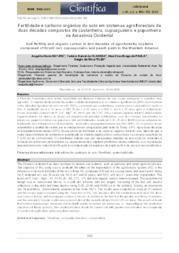Fertilidade e carbono orgânico do solo em sistemas agroflorestais de duas décadas compostos de castanheira, cupuaçuzeiro e pupunheira na Amazônia Ocidental.
Fertilidade e carbono orgânico do solo em sistemas agroflorestais de duas décadas compostos de castanheira, cupuaçuzeiro e pupunheira na Amazônia Ocidental.
Author(s): BUTZKE, A. G.; OLIVEIRA, T. K. de; PAULA, A. E. B. de; FIUZA, S. da S.
Summary: A Floresta Amazônica vem sendo substituída por diversos sistemas de uso, como pastagens e variados usos agrícolas. O objetivo deste estudo foi avaliar o efeito da implantação do sistema agroflorestal (SAF) na Amazônia sobre atributos químicos do solo em três SAFs, compostos por castanheira, cupuaçuzeiro e pupunheira, sendo o SAF A analisado aos 4 e 19 anos, o SAF B aos 7 e 22 anos, e o SAF C aos 6 e 21 anos após a implantação. Foram avaliados os teores de P, Ca2+, Mg2+, K+ , H+Al, pH, SB, CTC, V% e carbono orgânico total. O delineamento experimental foi em blocos ao acaso, em esquema de parcelas subdivididas, com dois tempos, constituídos da primeira e segunda coletas nas parcelas e três profundidades, sendo de 0-20, 20-40 e 40-60 cm nas subparcelas, totalizando seis tratamentos e 24 repetições, analisados independentemente nos três SAFs. Os resultados foram submetidos à análise de variância e as médias foram comparadas pelo teste de Tukey a 5%. Após duas décadas do estabelecimento destes SAFs, houve perda de fertilidade e de carbono orgânico total do solo, além de que a maior disponibilidade de nutrientes e quantidade de matéria orgânica ficou concentrada na camada superficial de 0 a 20 cm de profundidade. Os resultados indicam que são necessárias medidas de reposição de nutrientes e correção da acidez em profundidade ou, dependendo dos objetivos produtivos destes sistemas, sua implantação seja realizada com maior diversificação e complexidade de espécies de exploração e de serviços ecossistêmicos. The Amazon rainforest has been replaced by several use systems, such as pastures and varied agricultural uses. The objective of this study was to evaluate the effect of the implantation of the agroforestry system (AS) in the Amazon on chemical attributes of the soil in three AS, composed of Brazil nut, cupuaçuzeiro and peach palm, being AS A analyzed at 4 and 19 years old, AS B at 7 and 22 years, and AS C at 6 and 21 years after implantation. The levels of P, Ca2+, Mg2+, K+, H+Al, pH, SB, CTC, V% and total organic carbon were evaluated. The experimental design was in randomized blocks, in a split plot scheme, with two stages, consisting of the first and second collections in the plots and three depths, being 0-20, 20-40 and 40-60 cm in the subplots, totaling six treatments and 24 repetitions, independently analyzed in the three SAFs. The results were subjected to analysis of variance and the means were compared using the Tukey test at 5%. Two decades after the establishment of these AS, there was a loss of fertility and total organic carbon in the soil, in addition to the fact that the greater availability of nutrients and the amount of organic matter was concentrated in the superficial layer from 0-20 cm deep. The results indicate that nutrient replacement measures and in-depth acidity correction are necessary, or, depending on the productive objectives of these systems, their implementation should be carried out with greater diversification and complexity of species of exploration and ecosystem services.
Publication year: 2020
Types of publication: Journal article
Unit: Embrapa Acre
Keywords: Acre, Agroforestería, Agroforestry, Amazonia Occidental, Amazônia Ocidental, Bactris Gasipaes, Bertholletia Excelsa, Carbono orgánico del suelo, Carbono orgânico, Castanha do Para, Cupuaçu, Fertilidad del suelo, Fertilidade do Solo, Nova Califórnia (RO), Pupunha, Rondônia, Sistema agroflorestal (SAF), Soil fertility, Soil organic carbon, Theobroma Grandiflorum, Western Amazon
Observation
Some of Embrapa's publications are published as ePub files. To read them, use or download one of the following free software options to your computer or mobile device. Android: Google Play Books; IOS: iBooks; Windows and Linux: Calibre.
Access other publications
Access the Agricultural Research Database (BDPA) to consult Embrapa's full library collection and records.
Visit Embrapa Bookstore to purchase books and other publications sold by Embrapa.

